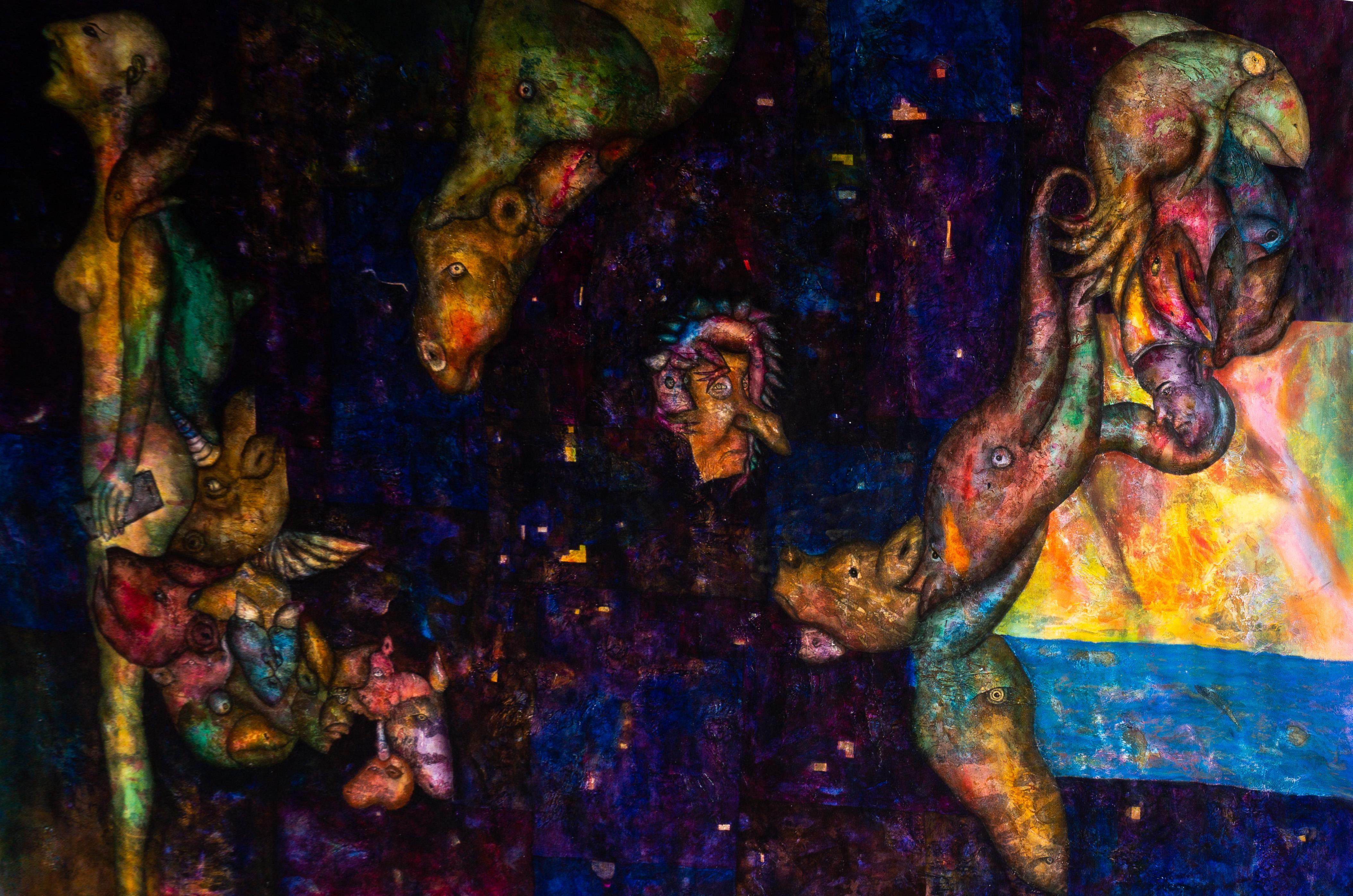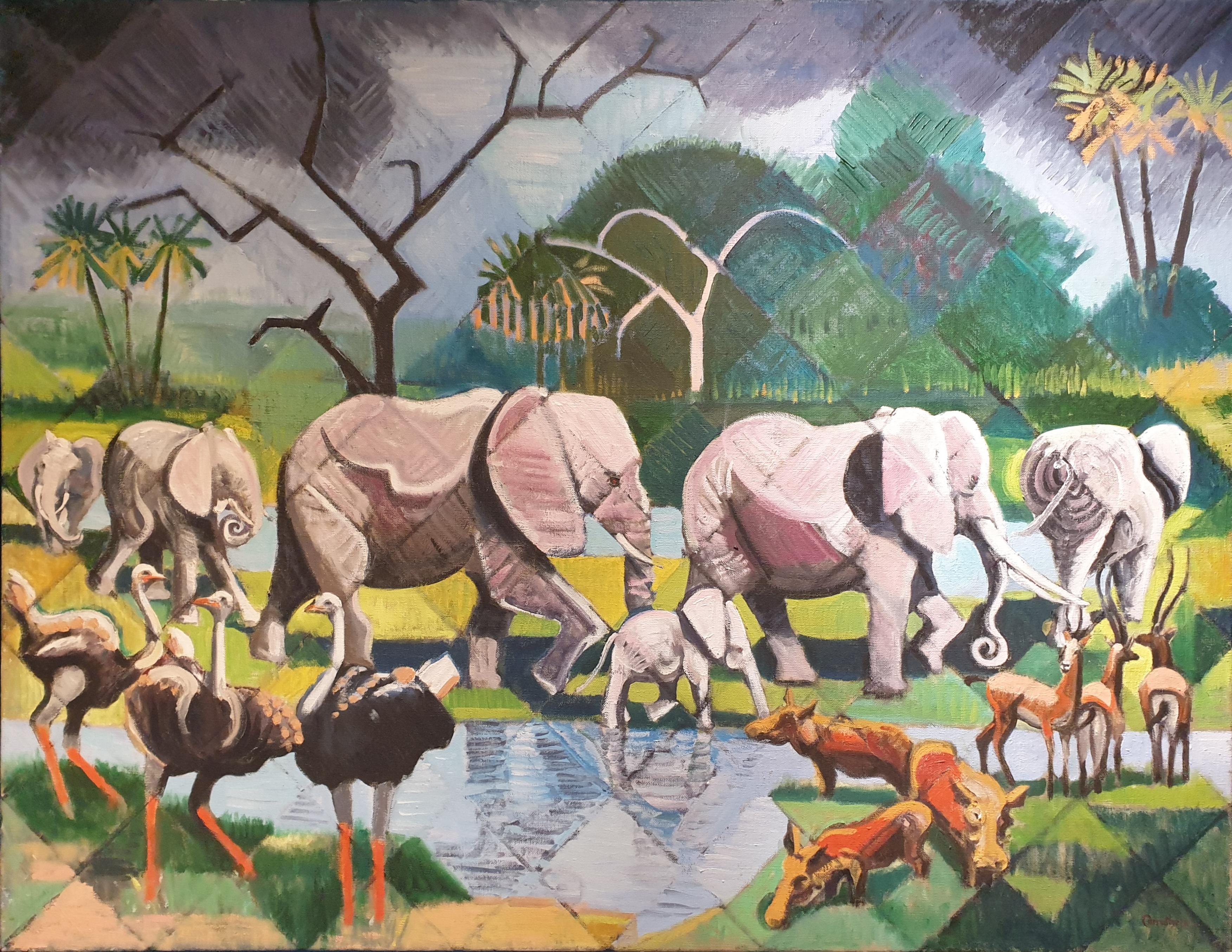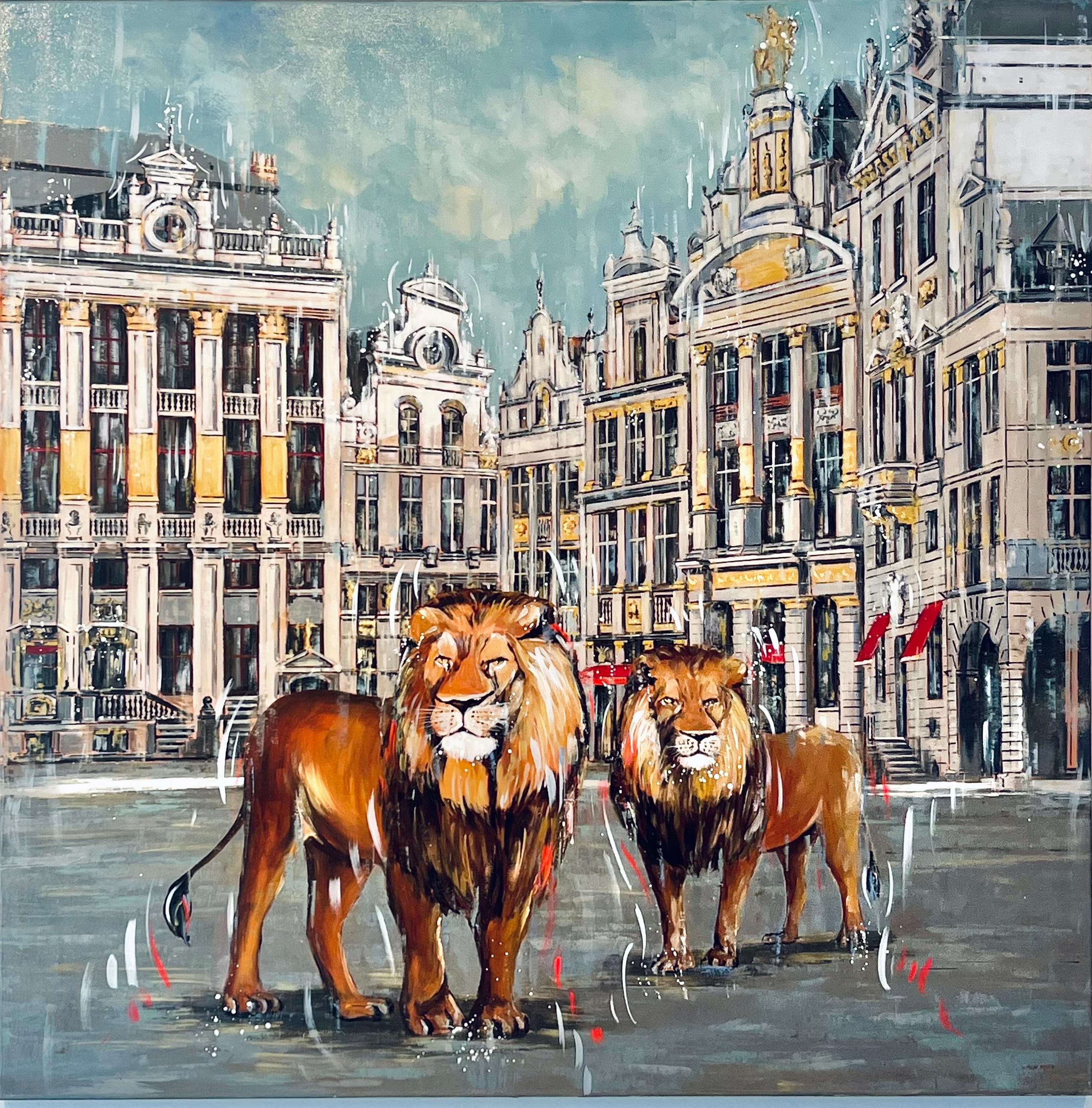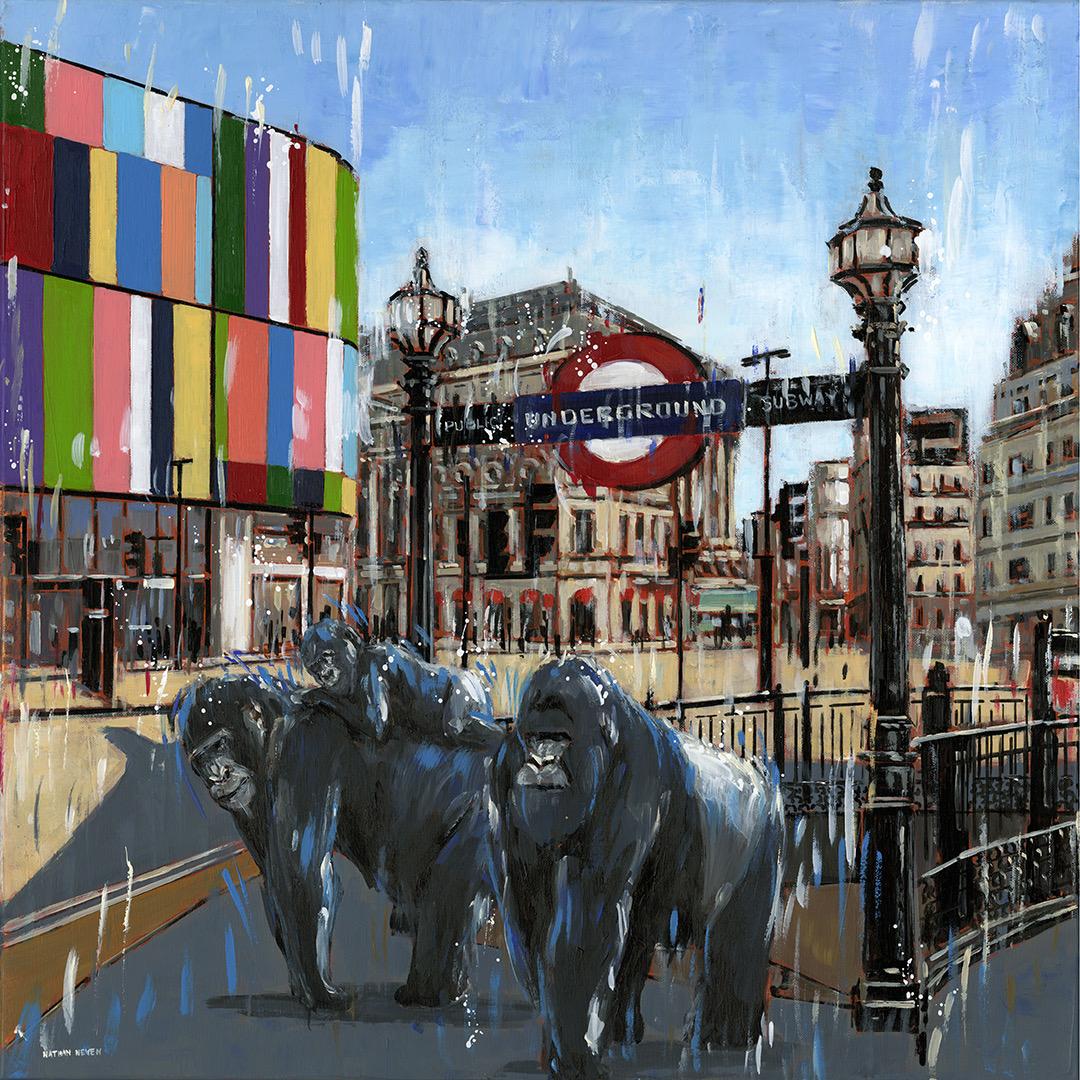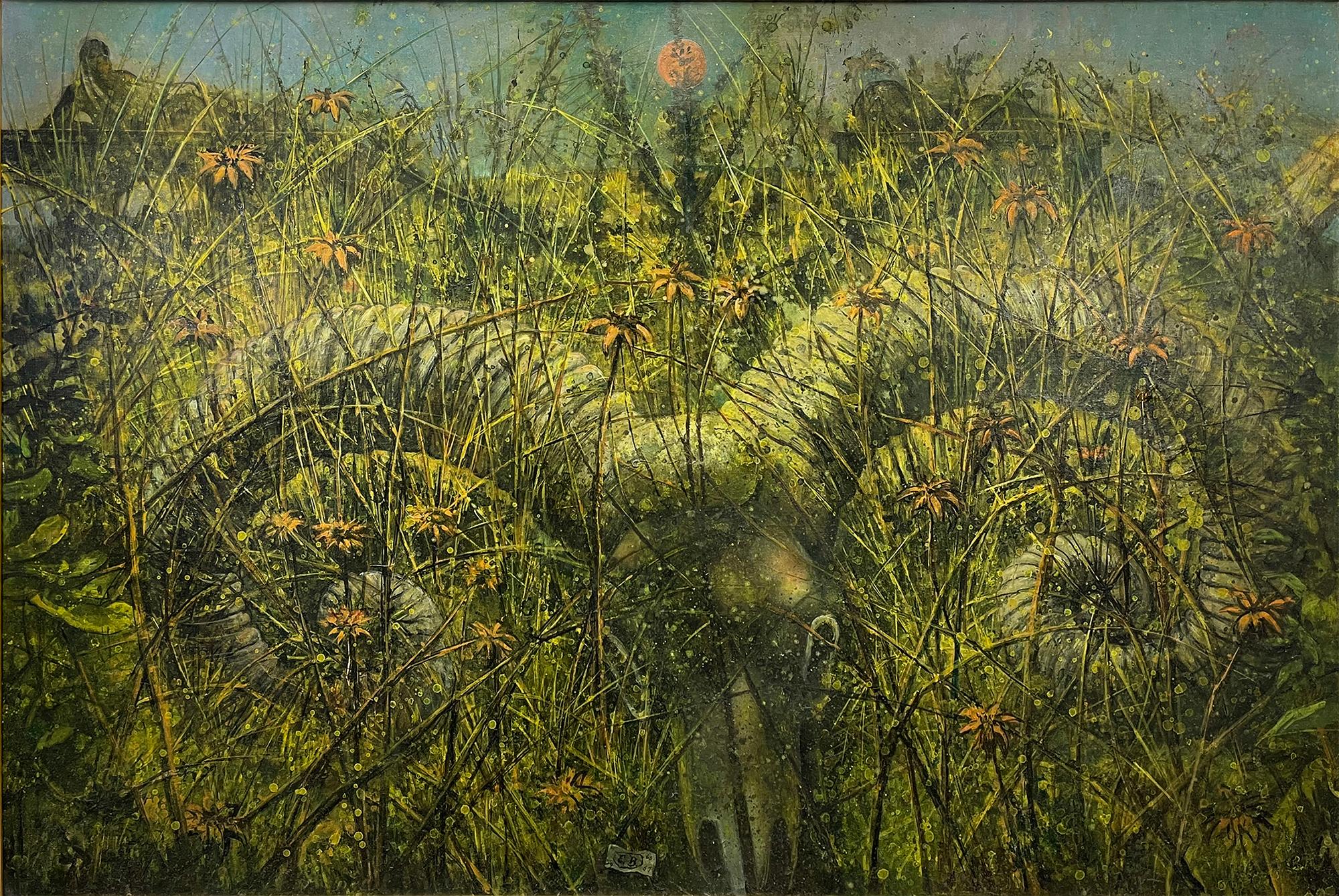Items Similar to Large Scale Surrealist Oil on Canvas, 'Noah's Ark and the Animals'.
Video Loading
Want more images or videos?
Request additional images or videos from the seller
1 of 23
Derek CarruthersLarge Scale Surrealist Oil on Canvas, 'Noah's Ark and the Animals'.
About the Item
Very large scale late 20th century oil on canvas of Noah's Ark and the Animals by British artist Derek Carruthers. Signed to the bottom right.
A magical, highly colourful and energetic painting of Noah's Ark and animals. A gorgeous composition in which Carruthers draws the eye from the wide base of the image through the centre, bouncing around the various beautifully rendered animals and then up up to the apex of the triangle, monumental in scale, to the goats, finally floating off into a dreamy beyond.
Colour abounds and strong shapes give the painting a magical energy whilst at the same time there is a softness to the brushstrokes that offer up a dreamlike quality reminding us that this is a fantasy world. A magical painting to engage the eye over and over.
Derek Carruthers was an artist who persisted in asking questions. His whole career was inspired by the determination to enquire into the nature of art, examine its purpose, and attempt to explore that place where the individual life of the mind meets the external appearance of the world - where personal sensation rubs up against cultural assumptions. Not surprisingly, Carruthers explored, over the years, a language of pure form, abstract space, 2- and 3-dimensions, narrative and concept, personal and universal figuration. Looking back, over decades of work, however, each of these voices is pursuing a coherent set of questions, reflecting on the stuff of human experience. Carruthers’ individual pieces can intrigue and charm, they can be warm and poetic; and they can also offer gritty resistance to the easy gaze - they can challenge us to think about ourselves, our environment, our expectations, our place in the world.
Carruthers grew up in the north-west of England having been born in Penrith, and one of his earliest memories of what art might be was formed by his encounter with the extraordinary creations of Kurt Schwitters. The latter had fled Germany in 1937, after his art had been labelled ‘degenerate’. He stayed, first, in Norway and then arrived in Britain in 1940. Carruthers had already encountered Schwitters' work as a boy, and had been launched on his own life-long examination of the nature of art.
Carruthers was further inspired by Victor Pasmore and Hamilton (British Constructivists) who were working closely together at King’s College London and eventually offered a challenging course to all first year students. Thus, Carruthers – who was at King’s in 1953-7 - was encouraged to take a rigorous approach to probing abstraction, spatial relationships, and the interlinking of art and architecture.
Having had the good fortune to have been an art student at such a time and in such a place, it is not surprising that Carruthers embarked on a voyage of artistic discovery. He showed his works with the major touring exhibition, organised by the Arts Council, in 1963, ‘Construction England’, together with Pasmore and Mary and Kenneth Martin. His work was also included in exhibitions of new art at the Drian Galleries, Porchester Place, in 1963-5. Reflecting the more recent re-examination of post-War, British Constructivism, Carruthers’ work was also included in the 1992 show, ‘British Abstract Art of the 50s and 60s’, held at the Belgrave Gallery. This early work, in which solid or relief forms change their nature as they – or the viewers – move through space and time, deliberately challenges the human tendency to find comfort in regarding the world as fixed and knowable.
In these years, too, Carruthers taught at Sunderland and Leicester Colleges of Art, before moving to lead the Fine Art course, as a Professor, at Trent Polytechnic (now the Nottingham Trent University). He was a dedicated educator, leaving to pursue his own art, full time, only in the mid-1980s.
Inspired, perhaps, by this freedom, the 1980s saw Carruthers exploring new ideas. He turned from working in 3-dimensions, or collage and relief, and rediscovered the power of traditional materials, oil and watercolour, on canvas and paper. He moved away from Non-Objectivity towards a practice which explored both abstracted and figurative imagery. Throughout, he remained preoccupied with exploring the human condition: by this trite remark, we mean that he continued to question how each individual experiences the world; he explored the ways in which human beings create totems to make their mark, as if to claim immortality; he tries to, ‘symbolise the triangular relationship between humankind and religion and the art / architecture which it inspires’. Hence - as well as warm glimpses of holidays and home life - his work yields the Egyptian pyramid, the Graeco-Roman heroic figure, the Christian monument; and, ultimately, the ‘sexless, ageless, raceless anonymity’ of the artist’s lay figure.
‘I was given an antique artist’s lay figure and acquired several smaller faceless wooden lay figures. I knew Man Ray’s “Mr. and Mrs. Woodman” series of photographs and enjoyed the irony and humour.' So began the series of figure compositions which seem to sustain themselves as symbol and metaphor for aspects of the human condition.
These figures have inhabited Carruthers’ paintings since the early 1990s. They may be placed in a fully-realised, 3-D space, their solidity asserted with dramatic lighting; or they may be flat, insubstantial. They may be gathered as a busy community or they may be isolated. They are always featureless. They can be translated as a deliberately ironic comment on life; they are also evidence of the artist’s continuing preoccupation with abstraction. He reduces and manipulates the figures so that they are, sometimes, in the Romantic tradition, a model of profound humanity, and sometimes - more challenging and chilling - Orwellian tokens of inhumanity.
Above all - we return to our opening remark - Derek Carruthers continued to ask questions, both about his life in a particular time and place, and about the lot of the human being on a universal scale. As an artist and a scholar, he saw himself at the intersection of these challenging states. And he makes you think........
- Creator:Derek Carruthers (1935 - 2021, British)
- Dimensions:Height: 47.92 in (121.7 cm)Width: 60.04 in (152.5 cm)Depth: 0.71 in (1.8 cm)
- Medium:
- Movement & Style:
- Period:
- Condition:
- Gallery Location:Cotignac, FR
- Reference Number:
About the Seller
5.0
Platinum Seller
These expertly vetted sellers are 1stDibs' most experienced sellers and are rated highest by our customers.
Established in 2000
1stDibs seller since 2020
155 sales on 1stDibs
Typical response time: <1 hour
- ShippingRetrieving quote...Ships From: Cotignac, France
- Return PolicyA return for this item may be initiated within 3 days of delivery.
More From This SellerView All
- Large Scale Surrealist Oil on Canvas, 'At the Watering Hole'.Located in Cotignac, FRLarge late 20th century oil on canvas of animals at the watering hole by British artist Derek Carruthers. Signed to the bottom right. A magical, highly colourful and energetic paint...Category
Late 20th Century Surrealist Animal Paintings
MaterialsOil, Canvas
- Apples, Hommage to Rousseau, large, square, naive work on canvas.Located in Cotignac, FRLarge square French fantasy naive oil on canvas by Jean Henry Brossat. Signed to the front and bearing a title in Russian (?) script to the rear. In a plai...Category
Mid-20th Century Animal Paintings
MaterialsCanvas, Oil
- Paysage de Neige Dans le Jura, Avec ChevreuilBy Gustave CourbetLocated in Cotignac, FRMid 19th century French oil on canvas of a snow scene in the Jura by Gustave Courbet. Signed bottom right in his characteristic 'ox-blood' red. Our painting is very similar in compo...Category
19th Century Realist Landscape Paintings
MaterialsCanvas, Oil
- Arco de ZocodoverLocated in Cotignac, FRMid Century oil on canvas view of the Moorish arch in the Plaza de Zocodover in Toledo, Spain by Louis Léo Hourdille. The painting is signed and titled to the back of the canvas. Ho...Category
Mid-20th Century Impressionist Landscape Paintings
MaterialsCanvas, Oil
- The Horse Drover, 19th Century Austrian School, Oil on CanvasLocated in Cotignac, FRA mid 19th Century oil on canvas of horses and their drover. The painting is signed MM, dated 1849 and carries a signature to the stretcher Marie Munch. The painting is presented in ...Category
Mid-19th Century Romantic Landscape Paintings
MaterialsCanvas, Oil
- Large Canvas Painting, a Group of Geese in a Spring Meadow 'The Gaggle of Geese'Located in Cotignac, FRLarge Modern French acrylic on canvas of a 'gaggle' of geese by Jean-Jacques Marais. Signed and dated bottom left. A bright and joyful painting of a group of geese (a gaggle) enjoyi...Category
21st Century and Contemporary Modern Animal Paintings
MaterialsAcrylic, Canvas
You May Also Like
- Blue DreamLocated in Bogotá, BogotáImmerse yourself in a unique visual experience with this oil painting in shades of blue and violet. The artwork features enigmatic figures of men and animals coming to life in a noct...Category
2010s Surrealist Animal Paintings
MaterialsPastel, Oil, Cotton Canvas
- Signed Surreal Southwest Modernist Desert Cactus Original Vintage Oil PaintingLocated in Buffalo, NYVintage American modernist surreal landscape oil painting. Oil on canvas, circa 1940. Signed. Unframed. Image size, 28"L x 20"H.Category
1950s Surrealist Landscape Paintings
MaterialsCanvas, Oil
- Grande Place-original cityscape wildlife animal architecture-modern artBy Nathan NevenLocated in London, Chelsea"Grande Place" by Nathan Neven is a captivating portrayal that transports the viewer to the heart of Brussels, Belgium. In this magnificent artwork, two lions roam the iconic citysca...Category
21st Century and Contemporary Surrealist Animal Paintings
MaterialsCanvas, Oil
- Family Day Off - London modern cityscape wildlife surreal abstract oil paintingBy Nathan NevenLocated in London, ChelseaIn this contemporary surrealist painting Nathan Neven juxtaposes a familiar city scene and classic underground entrance with the unusual presence of apes. This charming dream-like sc...Category
21st Century and Contemporary Surrealist Landscape Paintings
MaterialsCanvas, Oil
- The Night of the Ram - Desolate Surreal LandscapeBy Eugene BermanLocated in Miami, FLA desolate, surreal landscape with a haunting and mysterious outdoor still life featuring Ram's head emerging from the daisies and underbrush. Classical statues sit on the horizon l...Category
1960s Surrealist Animal Paintings
MaterialsCanvas, Oil
- "Frida Fish" Contemporary Surrealist Jewel Toned Tropical Ocean Life PaintingBy Henry David PotwinLocated in Houston, TXColorful, jewel toned painting by contemporary artist Henry David Potwin. The work features a surreal depiction of a tropical fish with the face o...Category
2010s Surrealist Animal Paintings
MaterialsCanvas, Oil
